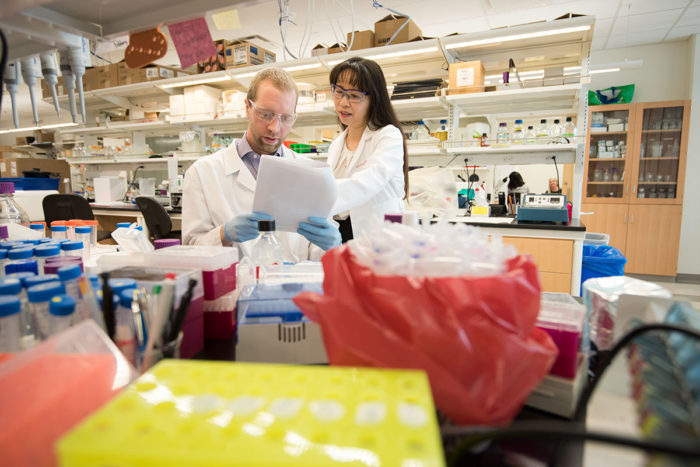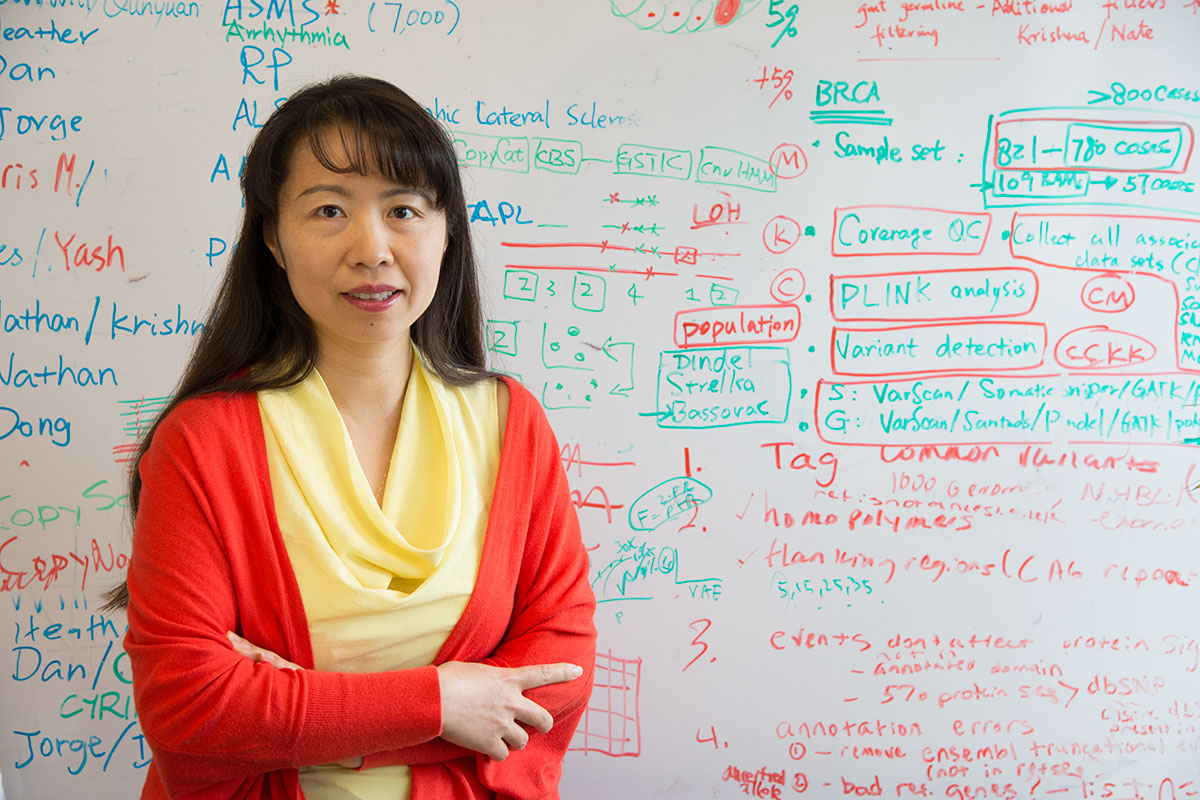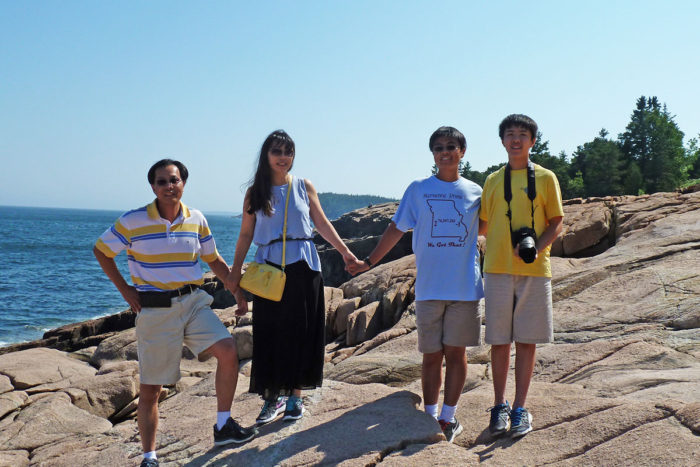Washington People: Li Ding
Computational biologist seeks ways to crack code of human genetics
 Robert Boston
Robert BostonLi Ding, PhD, right, works with Steven Foltz, a graduate student in her lab. Ding develops computational tools to study the genetics of cancer. To support and inform her methods for big data analysis, she also uses traditional lab techniques to further understand tumor biology, seeking new therapies for cancer patients.
Li Ding, PhD, is something of a cryptographer. Or perhaps reverse cryptographer is more accurate. Rather than writing code to conceal meaning, she works to decipher nature’s secret language.
Ding and her colleagues design new ways to translate the letters of the DNA sequence that make up the human genome into information doctors can use to treat patients, especially those diagnosed with cancer. But before she embarked on a career in computational biology — using bits and bytes to guide drug discovery — she had to get past that first frog dissection.
“Dissecting animals was not my favorite thing to do in class,” said Ding, with a laugh. “But I was fascinated by molecular biology so I stuck with my biology major. I also was very good at math and programming. Over time, I realized there was a way to combine the two, but back then I never could have anticipated what my future career would be.”
Today, Ding is an associate professor of medicine at Washington University School of Medicine in St. Louis, the director of computational biology in the Division of Oncology, and assistant director of The McDonnell Genome Institute. For more than a decade, she has been at the forefront of the field of genomics, with a special focus on the genetics of cancer. Her work has helped identify mutations — mistakes in the letters of the DNA sequence — that lead to cancer and that may provide routes to new therapies.
Many of the programs Ding and her team have developed have become standard computational tools used by cancer researchers, including those involved in The Cancer Genome Atlas and the St. Jude-Washington University Pediatric Cancer Genome Project. With names like BreakFusion, PathScan and SomaticSniper, these computer programs may call to mind spy novels, but in their case the enemy is cancer.
“Li has brought The McDonnell Genome Institute and the Division of Oncology world-class expertise in analyzing large genomic data sets,” said John F. DiPersio, MD, PhD, the Virginia E. and Samuel J. Golman Professor of Medicine, head of the Division of Oncology and deputy director of Siteman Cancer Center. “She has independently developed informatics platforms to provide key insights into mutations and DNA variants that are key to cancer initiation and progression. Her tools for deep and meaningful analysis of genomic data sets are now used by other leading cancer genomics groups around the world.”
Ding studied biology at Fudan University in Shanghai, China, where she met her husband, Feng Chen, PhD. The couple moved to the United States and earned doctoral degrees from the University of Utah, where Ding studied gene mutations and first became acquainted with large DNA databases. She then pursued postdoctoral training at Stanford University, where she learned to purify proteins.
After Stanford, Ding took a position with Incyte Genomics, a biotechnology company in Palo Alto, Calif., that has been called a gene-hunting pioneer and was one of the two major genomics companies existing at the time. The other was Celera Genomics, led by Craig Venter, which is well-known for competing with the Human Genome Project to be the first to complete sequencing of the human genome.
In June 2000, just a few months after Ding joined Incyte, the Human Genome Project and Celera both announced completion of “working drafts” of the human genome sequence. Ding remarked on her good fortune in entering the field at such an exciting time and at such an ideal place. Her training gathered together pieces of the puzzle needed to study cancer genetics: an understanding of DNA, knowledge of the proteins that result from the DNA code and, at Incyte, lots of computer programming.
 Robert Boston
Robert Boston“Everything about genomics was booming,” she said. “I had joined one of the leading computational biology and informatics companies in the country at the time. It was eye-opening for me. There was a gigantic server room in the basement at headquarters filled with high-performance computing capacity. I started to develop programs to facilitate large-scale discovery of different mutations and novel genes that potentially could be drug targets.”
Ding did not anticipate that her good luck in timing and placement would continue with her husband’s move to St. Louis for a faculty position at Washington University. She said she adored her Silicon Valley job and telecommuted to Incyte for several months after their move. But it did not take long for her resume to make its way to the leadership of The McDonnell Genome Institute at Washington University, one of only three large-scale sequencing centers in the United States, and one of the centers that led the Human Genome Project.
“They made me a special project leader,” Ding said. “I wasn’t quite sure what that meant, but I asked myself what I could do to contribute to such a great place. At the time, the Genome Institute’s main function was to produce data. So I started to help develop a programming pipeline to speed up the discovery of new genes. The work helped shift the focus from building the reference genome sequence to using the reference sequence for gene discovery.”
At the time, the major genome centers were using traditional Sanger sequencing, which is accurate but quite slow. The pilot study that laid the groundwork for The Cancer Genome Atlas — the NIH-funded effort to understand the genetic basis of 33 types of cancer — did not even sequence whole genomes. The pilot study focused on only a subset of genes in 188 lung cancer cases.
“I cherished the opportunity to be part of this project,” Ding said. “I got to work not just with computer scientists and biologists, but also clinicians who treated the patients whose cancers we were sequencing and analyzing.”
At around the same time as the tumor-sequencing project pilot study, Ding began working with Timothy Ley, MD, and DiPersio, both leading medical oncologists at Washington University and world-class experts in acute myeloid leukemia (AML), a cancer of the blood and bone marrow.
“Tim Ley and John DiPersio really had a vision to use the newest sequencing technique, next-generation sequencing, to study cancer,” Ding said. “Before this, next-gen sequencing was only used for the reference genome.”
In 2008, Ding was a key part of the team that published the first analysis of the complete DNA sequence — the whole genome — of a patient with AML. In fact, the study included two whole genomes. Ding and her colleagues sequenced all the DNA of a specific patient’s tumor cells and healthy cells. Comparing the healthy genome with the cancer genome of the same patient allowed the researchers to identify mutations that were likely to be driving the cancer.
“I was so excited when I saw the first tumor mutations coming out from millions of random short sequencing reads,” Ding said. “I couldn’t believe it. It was the first time I said to myself ‘This will work.’ It was mind-blowing.”
Mind-blowing because the new, faster sequencing technique expanded exponentially the amount of data that could be gathered — which, in turn, dialed up the importance of Ding’s work developing tools to make sense of it all.
Since then, cancer genome sequencing has revolutionized the understanding of how tumors form, change, spread and evolve resistance to therapies. Ding has studied breast cancer before and after metastasis as well as before and after treatment with common estrogen-lowering therapies. She has studied AML at diagnosis, during treatment and after relapse. Her work has revealed that cancer is always a moving target and that doctors may have to change their treatment strategies over time, even for the same patient, as the disease evolves.
Ding’s work also has contributed to the understanding that cancer is a disease of the genome, rather than a particular body part. She and her colleagues have found some mutations widely known in, say, lung cancer that play important roles in other cancer types — a finding that expands the number of patients who may benefit from drugs already approved for use. Most recently, Ding’s team has ventured into new frontiers of cancer proteomics — studies of the proteins involved in cancer — allowing her to dive deeper into the biology of tumors, where potential new therapies may be found.
“I feel like I came here at the right time, with the right background, and have had the awesome opportunity to work with world-renowned scientists and clinicians,” Ding said. “Our goal is to use our computational tools to understand big data so that we can provide medically relevant knowledge to doctors. And with that, we hope they can better treat their patients. It’s a dream job.”
 Provided
Provided





